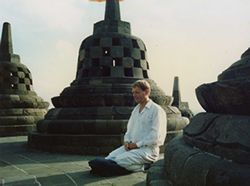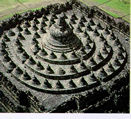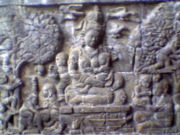What unites people all
over the world nowadays is their search for the Origin. All existing belief systems are
being broken down, including those of Buddhism. Since Sakyamuni proclaimed his Awakening
under the Bodhi Tree, the Dharma has only become more and more degenerated, culminating in
modern times, in which the ultimate treasure - Enlightenment - has turned into a
commodity. The "tool" of liberation has become an object of greed, hence it lost
its saving potential. Now, the first important step towards a new orientation is
acknowledgement of the breakdown of the existing paradigm. Rather than clinging to empty
practises, we should have the courage to admit our confusion e.g. disorientation.
Re-interpreting the times we live in, we come to understand that the outer decay has a
(hidden) meaning.
If the existing belief-system doesn't
satisfy anymore, we have to start the quest for the Beyond. To "cooperate with the
decay" reflects true wisdom. Because what is broken down nowadays? Right: it is the
ego with its accumulations. Burn-out is the condition of ego-collapse. Rather than
considering this as a "loss", the breakdown of self-centered attitude can bring
you to your center, your True Self. The more thorough this destruction is taken place, the
greater the chance, that you will realize your innermost core. Your deepest Self proves to
be Absolute Nothingness in which everything old, sick and ugly is broken down, while
simultaneously giving birth to the new, fresh and young. Hence, Nothingness is called the
"Cauldron of Regeneration". In pre-Buddhist times this was called the Cosmic
Womb or Great Mother.
This was reflected by the way people build
their burial grounds. Often, these were shaped as a womb. Newgrange in Ireland is the
supreme example of that. It consists of a huge womb-like structure. In the front is an
opening (vulva), through which you enter the secret inner space. Apart from burial ground,
these spaces were increasingly used as a "passage tomb", used for symbolic
rituals in which people were initiated in the mystery of "death and rebirth".
With the arrival of patriarchal religion (e.g. Buddhism) the function of these spaces
changed. Isn't it the main aim of Buddhism to "escape from the cycle of birth and
death?" It thus can be considered as a reaction to the practises of the Great Mother
religion. Men refused to "play the role of annual victims" anymore (in which
they had to "die" as Vegetation Gods) and escaped from the dominance of the
Feminine. It is thus, that they started their quest for immortality.
Generally - as far as we know of - the
stupa is a later development of pre-buddhist burial tumuli, dating from archaic e.g.
matriarchal times. It was considered a symbol of the Cosmic Womb ("Egg"), out of
which everything alive was (re)born and to which everything returned: indeed an object of
ancestor (mother) worship. Terms like Void, Emptiness, Nothingness and Nirvana are
corresponding with those early notions. The striking thing about Borobudur, the
"mysterious" Buddhist temple in Central Java, near Magelang, dating the 9th
century, is its huge Main Stupa, together with its 72 Buddha statues, each equally
surrounded by a stupa-like structure. It is the most striking thing about Borobudur.
Countless reports are describing the various mudra positions, held by the Buddha's, almost
none seem to be focussing on the stupa's the Buddha's are sitting in, though, to begin
with. What is so special about them?

1989 HMS Sermes (Servant/Messenger to the
Cosmic Mother)
alone (6 am) at Borobudur
First of all, all Buddhas sit in small
bell-like stupa structures covering them. It is corresponding with what the Prajnaparamita
Sutra calls "the Womb of the Buddhas", symbolizing their Enlightened State.
Enlightenment is equal to Emptiness. It is called (relative) Emptiness because the ego
disappears into it. The fascinating thing about Borobudur is, that it doesn't end here.
For in the center of this huge mandala-building the Main Stupa is situated. It is
symbolizing something (much) bigger than (individual) Enlightenment. It goes beyond
personal attainment. This Universal Stupa corresponds with "Emptiness beyond
Emptines" or Absolute Emptiness in which Relative Emptiness (Enlightenment)
disappears, also called Nirvana or Absolute (Dark!) Bottomlessness of the Cosmos. In
Buddhist temples throughout in the world the Buddha is the central figure. Borobudur
transcends this by putting Nirvana (Absolute Emptiness, Cosmic Womb) into the center.
Thus, the minds behind the Borobudur were aware of the fact that "individual"
Buddhahood is NOT the Ultimate Reality. That's why all small stupa's are eventually
culminating into the Great Stupa or Universal Womb on top of the temple. Borobudur
therefore is a absolutely unique symbol of Ultimate Truth.
The final "proof" is provided by
the innumerous Kala (KalaMaka, Mahakala) faces in the temple. They are generally known as
the "God of time" or guardians. However this a very late (patriarchal)
interpretation. In fact Kala ("The Black One") is a direct memory of the Dark!
Cosmic Womb. Kala therefore is equal to the Original Great Mother, coming from Sumeria,
through the Harappa culture e.g. pre-Hindu times. She is shown in Her destructive aspect,
with big "monstrous" heads. Her "function" (in these times of
Kali-Yuga) is to destroy egoism, selfishness, greed and ignorance. All the several
hundreds of Dyana Buddha statues of Borobudur have a Kala on top! It is the final
indication, that Kala is the Supreme Principle, the deep Dark from which the Light
emerges.
BOROBUDUR 2
will elaborate this further!
Add to it a typical feature of those
times, in which the burial tumulus was protected by various guards or warriors, positioned
around the site, all with their faces looking to all directions. Normally, in a Buddhist
temple, the Buddha(s) are the central figures. The guardians at the gate are always
"lower" status deities. The striking thing is, that at Borobudur the Buddhas are
NOT in a central position. On the contrary, they occupy positions at the periphery.
Moreover, their faces are looking to the outside of the complex. The unique feature in
Borobudur is, that the Buddha's - just like all male guardians of pre-Buddhist times - are
thus located - not in the center as it is commonly the case - but at the periphery,
meaning that they are not the most important figures of the universe. On the contrary,
they are servants, exercising their function as guardians e.g. forming a big
(devotional/security) circle around the Great Stupa (Mother's Womb),* thus confirming our
hypothesis of Borobudur being a relic of matriarchal times**.
* Including a huge Buddha, again
not as the center of worship, but sitting as a guard (!) in a small complex - the famous
Mendut temple - at the entrance of Borobudur...
** Together with the fact, that
Borobudur has been built as a lotus-mandala, the lotus, as we have seen, being a symbol of
the Womb in her own right! One racy detail: King Rakai Panangkaran who conceptualized
Borobudur also built a Tara (Buddhist manifestation of the Great Mother) temple in
Yogyakarta, "proof" of the dominance of the Feminine at those times.
** There is another surprising
link. Borobudur was originally built as a Hindu (Shiva) temple. Its traces go further back
though. The architecture has strong similarities with a mesopotamian Ziggurat (pyramid)
temple. And Mesopotamia was the cradle of Mother Worship....
Because the womb imagery of Borobudur - in fact the whole monument is like a big burial
hill - is most prominent, the origin certainly has to be located in pre-historic times.
But not only that! We have explored links in the lineage, for the first time revealing the
secret of Borobudur! Our discovery is the Yogacara-school being the source of inspiration
on which the Borobudur has been built. Terms like "Matrix World" (together with
"Diamond World", symbolizing the God-Son/Buddahood being born out of the Cosmic
Womb) representing the Ultimate Reality (Dharmadhatu), together with concepts like
"Womb of the Tatagatha" ("Tatagathagarbha") were greatly emphasized at
that time, later to be found both in Tibetan (Tantra) as well as in Japanese Esoteric
Buddhism (Shingon). Add to it that Borobudur is designed as One Big Lotus, and the Lotus
standing for Cosmic Womb - think of the "Jewel in the Lotus" - then it is
certainly not that wierd to suggest that not the Buddha stands at the Center, but the
Cosmis Womb does. And that is indeed the Ultimate Reality!
Mythology is giving us even more clues.
Borobudur was built by a royal family, called the Sailendra's, who emphasized to be
"Kings of the Mountains", something usually claimed by God-Sons of matriarchal
times. Moreover, a Princess - Sri Kahulunan - is said to have played a major role, which
is very uncommon in the history of Buddhism. Rather than being the accomplice of her
husband, she might very well have been a central object of veneration and inspiration. Add
to it the countless sculptures emphasizing a life-affirmative attitude - which again
characterizes the Yogacara period in India - very much corresponding also with the
indigenous Javanese lifestyle - the latter logically susceptible to corresponding
influences - the conclusion Borobudur being a center of Womb worship maybe not far from
the truth.
Not surprisingly thus, that the space
under the Great Stupa is empty, symbolizing the Ultimate Emptiness of the Cosmic Womb.
J.L. Moens* claims that Borobudur fits
very well in ancient Javanese cultural belief of "death and rebirth" of the
rulers, in our case the Sailendra-rulers. The latter were said to descend from the
mountains, as said above a very ancient (pre-Buddhist) mythology. In that VERY ancient
past this "death and rebirth" took place in the Cosmic Womb! Imagery of the Womb
and the mountain comes together in the Main Stupa of Borobudur. It is confirmed by
spiritual Realization, where The Great Emptiness ("Nirvana") is the Supreme
Realization. This is completed by later Buddhist expectations of Maitreya descending from
the Tushita Heaven, who - through the Main Stupa (Womb) - will have his magical birth into
this earthly realm. Maitreya thus being the "Son of the Mother", just like these
most ancient God/Kings of archaic (Sumerian) times. Indeed, Maitreya (and Buddhas) of
Javanese Candis are often portrayed as kings. Again proof of the fact, that to REALLY
understand Javanese Hindu-Buddhist culture one has to go beyond it. For both cultures were
integrated in an already existing framework of archaic tradition: that of the (Sumerian)
mythology of the Cosmic Mother and Her Son/Lovers (God/Kings). It corresponds with those
Kebatinan groups who try to reconnect to their original (pre-Hindu) roots.
* J.L. Moens "Barabudur,
Mendut en Pawon"T.B.G. 1950. Together with T. van Erp and N.J.Krom he belongs to the
most outstanding Dutch scholars of Indonesian culture and religion.
Moreover, the pilgrim at the Borobudur,
the merchant Sudhana - a layman, not a monk! - from the Gandavyuha epic, is on his
quest for Truth (Emptiness) e.g. Ultimate Truth (Emptiness beyond Emptiness). The latter
being the Essence of the Cosmic Womb. It complies fully with the symbolism of the
Borobudur as the sanctuary of the "Eternal Feminine". Sudhana is thus searching
for the Great Mother!* Not surprisingly thus, that he has its most prominent encounter (in
the Vairocana tower) with.....the Bodhisattva Maitreya. Isn't Maitreya the Messenger of
the Mother, after all?** It is the former who initiates Sudhana into the true nature of
Emptiness...... He leads him back to his True Home, the Cosmic Womb. The importance of
which is demonstrated by the fact, that this stage of the journey occupies the greatest
space in the Borobudur's reliefs and galleries. Once Sudhana grasps the meaning of
Emptiness, Maitreya immediately shows him the entire universe as the interdependence of
all things and events. This interdependence reflects Mother's "web of life". It
is part of the ancient notion of the Law of the Universe: death, rebirth and permanence,
as was and still is worshipped in Hinduism***. Maitreya showed Sudhana the ultimate stage
of the Way: that of all-embracing love toward all beings, reflecting the All-Embracing
Nature of the Mother. Eventually, he sents him to the Bodhisattva Samantabhadra, the
(again feminine) embodiment of compassion and goodness toward all sentient and
non-sentient beings.
* Remarkable is that the Sudhana
story takes place on the third and fourth galleries close to the Great Stupa, while the
tale of Siddharta/Gautama/Buddha is on the lower first and second, suggesting an
evolutionary sequence from the latter to the former. Moreover, Sudhana starts his journey
by visiting a Goddess!
Borobudur:
the Holy Grail of Buddhism
** This universal myth is also
reflected by the Chinese concept of Laomu - the Venerable Mother - and Her Son Maitreya.
See: "Origins, Prophesies and the Messenger".
*** As we know Borobudur was
greatly infuenced by archaic India.
"Sudhana beholds the entire
evolutionary history of Maitreya from a self-centered, unenlightened being to a
functioning Buddha. At the same time, the panorama unfolds in infinite resonant variations
in every atom of the universe, each containing infinite micro-universes, which contain
infinite worlds where infinite living Sudhanas enter infinite Vairocana towers and behold
infinite evolutionary panoramas of infinite living Maitreyas."
From Thurmon "Mandala, the
Architecture of Enlightenment"
The Sudhana story very much reminds me of
the Western Medieval Parsifal Legend. The parallels are so striking, that a common source
is likely. Not surprisingly, for men's spiritual Quest is ultimately related to archaic
times, especially that of Sumeria when Gilgamesh started his quest for immortality......In
the latter's case he failed to realize it. Instead, the Mother showed him the ultimate
meaning of life: "doing good". Hence, he returned to his city Uruk, where he
spent the rest of his life caring for his people. The same with Parsifal. His whole
journey is characterized by his Quest for the Ultimate. Eventually he finds the Grail,
symbol of the Cosmic Womb, Source of limitless abundance. However, it is only after
realizing that selflessness and compassion - key characteristics of the Original Mother -
are the ultimate goals of the Way, that he finds his true destination: that of becoming
the Grail Priest/King. Sudhana also reaches Attainment, and like Gilgamesh and Parsifal he
eventually is taught to "do good". All three are part of a universal theme.
Gilgamesh-Sudhana-Parsifal
This is more than overwhelming. On Java,
the archaic concept of the Mother and Her Son/Messenger has found its most prominent
expression. Hence, Great Mother Buddhism - with Maitreya as its Green Messenger* -
is considering Borobudur, together with Candi Mendut - of course sharing it joyfully with
all other Buddhist denominations worldwide - as the main earthly Center of its universal
worship. It is one of the most sacred places on earth. The one that includes the promise
of a New Era. Devotees are therefore being recommended to at least undertake one
pilgrimage to Borobudur once in a lifetime.
Praise the Great Mother!
* See: Opening
page |




